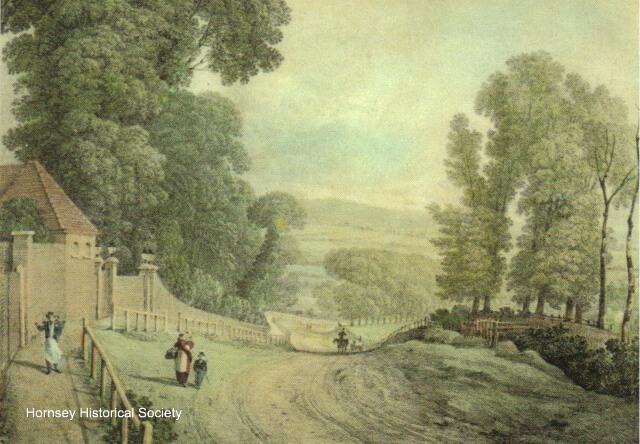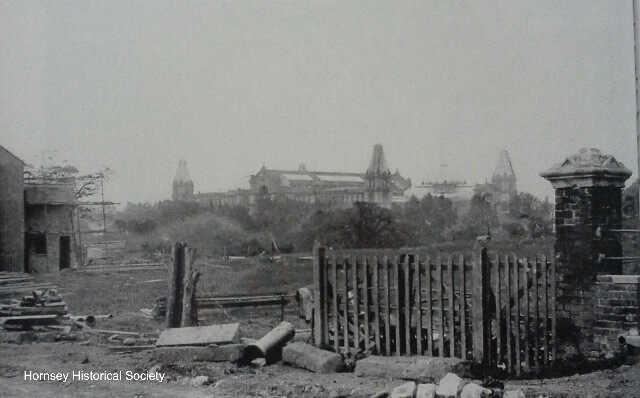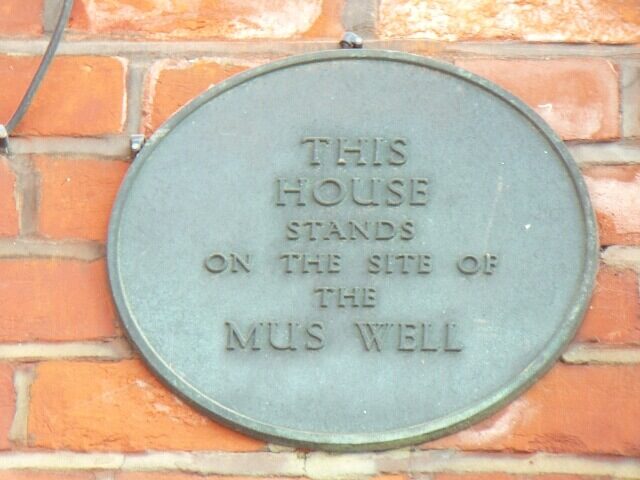A 1972 series of Hornsey Journal articles by Ian Murray, first Chairman of Hornsey Historical Society and Haringey Council Archivist. The HHS gratefully acknowledges the kind permission of Archant/Ham and High to reproduce this article.

Because of its geographical isolation, Muswell Hill remained something of a rural backwater even by Hornsey standards, until 80 or 90 years ago (now nearly 140 years ago – editor). The Hearth Tax returns of 1674 indicate that only 30 houses existed there and at Fortis Green. A public house, however, undoubtedly the Green Man, had stood at Muswell Hill from at least 1552, and probably before, when an alehouse at Muswell Hill iuxta (next to) Haryngseye, is listed in the Middlesex Justices’ alehousekeepers recognisances.
The Hill in medieval times was surrounded by forest. Tottenham Wood to the north covered what is now Alexandra Palace and Highgate. Coldfall Woods were also nearby. Until the Hornsey Enclosure Act 1813 much of it particularly on the east side of the hill, in the St James’s Lane area, comprised Muswell Hill Common. To the north, as far as Friern Barnet, lay Hornsey Common. This wooded and largely pastoral area with few inhabitants was extremely dangerous for travellers who went along the road to Barnet. As we shall see later, it was the scene of much crime and highway robbery.
Chapel and dairy
The name Muswell Hill does not, as far as is known, occur earlier than 1561, though Muswell or Moswelia occurs in 1151. The old name for what is now Muswell Hill was Pynesknoll or Pynesnot, in various forms and spellings dating from about 1280. This means Pin’s Hill, Pin being an Anglo-Saxon personal name appearing again in Pinner. This name was forgotten after the 18th century when the form Muswell Hill became favoured.
In 1112, 64 acres of land around Muswell were granted to the Nuns of Clerkenwell by Richard de Belmais, Bishop of London, who as we have seen, held the manor of Hornsey. The nuns built a retreat, chapel and dairy farm on the land and because it was occupied by Clerkenwell nuns it was considered to be part of Clerkenwell itself, becoming known as Clerkenwell Detached. It was not until 1900 that this area was returned to Hornsey for administrative purposes; up to that time the inhabitants even had to go to Clerkenwell to vote.
The boundaries were Goodwyn’s Vale to the north, up Colney Hatch Lane to Duke’s Avenue which formed the southern boundary as far as Rosebery Road, and from there in a large curve to Goodwyn’s Vale again through St Andrew’s Church in Alexandra Park Road.
John Goodwyn
On 6th September 1539, the Priory of Clerkenwell was dissolved and with it the chapel and farm on Muswell Hill. The prioress and nuns were not turned out into the cold but were all given pensions by the Court of Augmentations, the authority which dealt with revenues deriving from the sale of monastic lands. From then on this part of Muswell Hill changed hands frequently.
In 1549 ‘the great messuage of farm called Muswell Farm in the tenure of Henry Lodsman and John Avery’ was granted to John Goodwyn, a merchant taylor of London. John Goodwyn is now remembered by Goodwyn’s Vale. Both Lodsman and Avery were more than of usual interest for both were favourites of Henry VIII. Avery was Yoeman of the Bottles and Lodsman was Serjeant of the Chaundry, or keeper of the candles. Both men were picked by Thomas Cromwell to serve on juries in the trials of those out of favour with the king, such as Anne Boleyn, and to return verdicts favourable to him. For their services they had been rewarded with estates at Muswell Hill. After the Reformation monastic lands seized by the king were often granted to his favourites.
Julius Caesar
Sir Julius Caesar, Chancellor of the Exchequer and Master of the Rolls under James I lived at Muswell Hill. His father, Caesar Adelmare, an Italian, had been a physician to the court earlier in the century and his sons had taken his Christian name as their surname. It is not known exactly where Sir Julius lived. A map of the Manor of Tottenham dating from 1619 shows his house called Mattisons lying to the west of Tottenham Wood and it was almost certainly in Clerkenwell Detached. For a selection of images of Sir Julius see the National Portrait Gallery.
In 1577 the Muswell Hill Estate passed into the hands of the Rowe family, mentioned in Norden’s History. This family produced three Lord Mayors of London, a dramatic poet who is now forgotten except for his editions of Shakespeare, and one of the judges who condemned Charles I, Colonel Owen Rowe. At the Restoration he was himself condemned to death but was reprieved and finally died in the Tower of London in 1661. He was buried in Hackney Church where most of the same family are buried.
Another member, Sir Thomas Rowe, was an ambassador to James I. He sailed 200 miles up the Amazon and then proceeded on an embassy for the king to the Court of the Great Mogul, Jehangir, Emperor of Hindustan (India). About 1700 Muswell Hill passed into the hands of the Pulteney family where it remained for the rest of the century, Sir William Pulteney becoming in 1795 the first Earl of Bath. About 1750 an attempt was made to turn Muswell hill into a spa – but without success.

The Mus well: ‘a spring of fair water’
Muswell means quite simply ‘the mossy well’ and this well, which from early times was considered to have magical or curative properties, was in existence until c.1880 when it was filled in. The spring which filled it was diverted. The well is clearly marked on the Ordnance Survey map of 1870 and, according to correspondence in the Hornsey Journal in 1904, the actual site is in Muswell Road. One of the houses carries a plaque on the wall, above where the well was located.

The nuns controlled the Mus well which was mentioned in John Norden’s Speculum Britanniae of 1593. He wrote:
‘at Muswell Hill, called also Pinnersnall Hill, there was a chapel sometime bearing the name of Our Lady of Muswell where now Alderman Rowe hath erected a proper house. The place taketh the name of the well and the hill, Muswell Hill, for there is on the hill a spring of fair water which is within the compass of the house. There was sometime an image of the Lady of Muswell, whereunto was a continual resort in the way of pilgrimage, growing as is fabulously reported in regard of a great cure which was performed by this water upon a certain King of Scots who being strangely diseased was by some divine intelligence advised to take the water of the well in England called Muswell, which after long scrutation and inquisition, this well was found and performed the cure…’
John Aubrey in his Miscellanies, published in 1696, mentions that, ‘the water of this well is drunk for some distemper still’. Until the Dissolution of the Monasteries, Muswell Hill was the object of pilgrimage by thousands of Londoners who came either through Crouch End and up the Hill, or through Highgate and along what is now Muswell Hill Road.
Image credits
HHS Archive